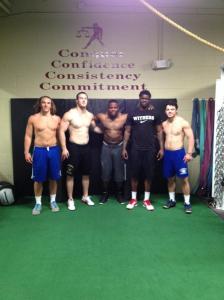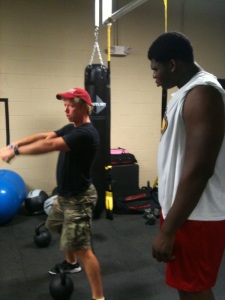As both a ‘personal trainer’ and strength & conditioning (S&C) coach into my 4th decade of work, my view of the profession is broader than what any “soundbite” or general observation can provide.
A recent article from USA Today (from August 19, 2015) highlighted a common aversion that sport team coaches, especially in football, have regarding their players training with personal coaches to improve their individual performance and potential. I am going to present a balanced, counterpoint to the “case” made in that piece.
Editor’s note: You may need register to load this archived article
http://www.pressreader.com/usa/usa-today-us-edition/20150819/282183649791716/TextView
I’ve addressed the role of a personal S&C coach on podcasts, in articles, and even recorded an audio product a few years back about the ‘state of the union’ in today’s fitness and S&C fields and the benefits of a qualified private coach.
Editor’s note: For sake of this article, coach and trainer can be used interchangeably although there can certainly be a discernible difference in the two. As well, it is known that there are both men and women as qualified coaches.
Though we’ve made undeniable progress in the field of athletic preparation, in regards to attaining scientific validation of many of our chosen training methods, and in ‘program design’ for greater work/recovery efficiency, there’s also a most evident downside that has “progressed” as well—
The dilution of a field, once consisting of a streamlined group of coaches in it for the primary purpose of developing a healthier and better performing athlete.
As with most any vocation that involves personal service, ulterior motives such as image, ego, and financial gain will be the attraction for those who are purely self-serve-driven. For more than half a century, the world of competitive sports has attracted plenty of “characters” into an athlete’s entourage so this is certainly nothing new or surprising. The place where the line is crossed is when any professional outside the structure of an organized team or individual sport is thrown into the same category as a posse of opportunists.
Make no mistake, one of the incentives of a personal S&C coach is ‘to be in business’ to make money, to handle their personal, family, and business financial responsibilities, and that’s certainly not a problem. The problematic issue arises when a coach is using an athlete, or athletes, to create an “image of relevance” and build a career that would not be there otherwise. When this is the case, there is a certain conflict-of-interest that occurs as the personal coach becomes a “pimp” of sorts and a subsequent divisive component in the athlete’s development and relationship with his/her team.
Fortunately, this scenario is not the rule but the exception, yet it is becoming increasingly more common. And, when it does occur it gives credence to team coaches for being suspicious, and often times downright antagonistic, to any coach in private practice.
As with most career choices, when quantity substantially increases, quality substantially decreases. In my assessment, nowhere is this more evident than in the S&C industry. And, reality is that it’s an industry where someone can learn just enough technical jibberish and apply a heavy dose of charisma and marketing to deceive a large percentage of young athletes and their parents into thinking they are the answer to fulfilling their dreams.
Considering that “trainer certifications” can be obtained literally in a matter of hours at a weekend workshop, and considering anyone who “benches and squats a lot”, does 50-inch box jumps on YouTube, has a few tattoos along with the Mr. Clean hair style, and a social media account can call themselves an “expert”, it’s easy to understand why we are headed on a clear path of compromise in an ever-increasing, watered-down genre of performance coaching.
As I’ve sincerely stated many times, I can teach a 5 year-old how to just wear someone out.
I realize that bringing up this issue will necessitate a “well, what’s the solution?” response. The answer lies in awareness and accountability. It’s the responsibility of each authentic S&C professional to uphold personal standards of commitment, integrity, humility, respect for colleagues, and the insatiable desire to be a better coach with continuing education. And, this continued education has little to do with letters after your name and everything about understanding that you never stop learning.
Adhering to the above principles will insure that we keep industry standards where they need be, and that itself can go a long way in warding off those with less than the respect, dedication, servility, and diligence essential for true success and longevity in the field of athletic preparation.
As well, the coaching circle must tighten-up. Coaches are better when viewing each other as associates, a part of the progressive process, where each of us brings unique qualities and assets to the coaching continuum. The childish criticism, biases, jealously, and back-biting often seen tends to manifest when there’s a gap of insecurity in the coaching circle.
Social media and marketing has plenty of positives, yet can also lead to an atmosphere of who can throw around the most technical, yet confusing and inapplicable, terms, “recruit” the most followers, bash the most competitors, and pander to people’s sense of ambition through their feelings of insufficiency and inferiority. As tempting or justified as you may deem it, success in the S&C field is never about impressing people with what you think you know or trashing other coaches or their methods, but about minding your work with a spirit of humility, clarity, and confidence.
As cliché as it may sound, coaching is best when it’s a brotherhood. It’s a mature coach who understands that we train the person first, then the athlete. This coach will have trusted go-to colleagues to call on to help produce a more complete product, a better result, and be quick to return the favor when called upon.
Every training principle in existence has been around long enough that only a fool would believe otherwise. Thus, egos can take a rest when someone thinks they’ve originated anything along the lines of training methods and techniques. The individuality is purely in the realm of application of these principles.
Individual coaches may have developed certain “systems” and programming that are more proficient or efficient than another, and each coach has areas they are more skilled in as well as those aspects of the athletic preparation spectrum they need more assistance in. The tighter the circle, the stronger the circle. This can obviously lead into an entire topic of its own for a future article. Suffice to say, confidence is needed in coaching though it’s value is entirely dependent on humility and mutual respect for colleagues.
Exhibit A: There are people in ‘any’ personal service profession that are in it for self-serving reasons and the S&C industry is not immune to that. It may sound self-righteous to point out there are those in “training business” purely for the incentives of making money and making-a-name. Notice I did not say these reasons are “wrong”, as for those individuals it may in fact be their best rationale. That’s reality…and simply put, ‘client/athlete’ beware.
Exhibit B: There are people in a specialized personal service business with the primary incentive being to serve the specific needs of others. There are potentially major performance-enhancing, injury-preventive, and yes, psychological advantages and benefits in hiring, and working consistently with, a qualified personal performance coach. There’s no arguing that a sport like football is a team sport, however, the best teams are made up of individuals that are at their best for the team by taking accountability to be at their best.
Even the best ‘in-team’ training programs– at the most elite high schools and colleges– are limited in what they can address for the individual in regards to optimizing their fullest potential. Qualified personal coaches can assess and address specific attributes of the athlete in a way far beyond the scope of a team setting. Key areas like mobility, speed and agility mechanics, and even lifting technique get little to no attention in the team environment due to logistics or fact that even the best football coaches are not necessarily qualified S&C coaches and lack the skills to teach these techniques.
That said, the value of ‘in-team’ workouts at school need not ever lose their significance. It’s not an “either or” issue. I prefer to call the training an individual athlete does “on their own” as beyond the team responsibilities as opposed to “outside” of it. Consider it in the same perspective of an athlete staying after practice for extra work while his teammates may have hit the showers. It should not be a divisive measure, but observed as one that inspires teammates and positively impacts the team.
It’s understandable that a team’s head coach, and other members of the coaching staff, will be hesitant to jump on board with someone “on the outside” influencing their kids. This is especially true in football as the in-team weight room and conditioning workouts are used, to a large extent, as a place to galvanize, discipline, and even punish the kids.
Over the years, I’ve had a relatively small group of head coaches who take the time to actually investigate the benefits of a non-staff S&C coach. Much of this hesitancy comes from failure to differentiate between a team’s performance and discipline. It’s similar to how any parent would feel if someone ‘outside the home’ came in to discipline their kids. It’s an understandable misperception, yet with a solution better than ignorance and settling for sub-optimal performance.
A qualified personal coach will understand the necessity of designing the athlete’s work done beyond the team in a way that complements the in-team workouts and never compromises the authority of the team’s coaching staff or the unity of the team. I personally communicate with each of my athletes that they are not to standout in any fashion that alienates teammates, but to take accountability as a leader to a whole new level.

The personal coach can be a significant asset to not only individual players but also the team in general with a greater presence of leadership. As well, the coaching staff can benefit by focusing more on what their speciality is, the actual sport. Again, it’s not an ‘either or’ dilemma but a healthy integrated approach, with communication that eliminates the unnecessary confusion and conflict. And, this all begins with the maturity of the personal S&C coach and willingness of team coaches to become better educated. When this understanding is in place, the bottom line is: a better prepared individual will not only be helping their future but also be a stronger component for the team.
–VM


